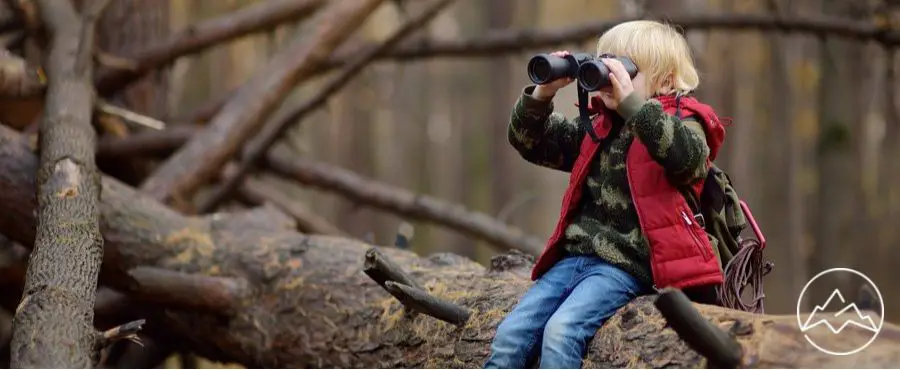A pair of binoculars is a great gift for a child interested in nature or your recently retired father looking for a new hobby but knowing how to buy binoculars is not straightforward.
Choosing a pair of binoculars depends on how you want to use them. If you are someone who just likes to sit on your deck and look at birds every once in a while, then you will need something different than an avid birdwatcher.
Binoculars range in size and price. It is easy to drop over a thousand dollars on a decent pair. However, purchasing a very good pair of binoculars for a low price is possible. Understanding binocular specs and a binocular’s magnification will help you make an informed purchase.
Below we will go through a few important guidelines to consider when purchasing a pair of binoculars.
Understand the terminology
When you first go to purchase a pair of binoculars, you will see that each pair comes with a rating that includes several sets of numbers. For instance, you might see a pair that says 8×42, or 10×50.
The first number is magnification. Binoculars with an 8×42 rating can magnify up to eight times. That means whatever you view through the binoculars is eight times closer. If you are viewing an object at 800 yards, it will appear through the binoculars as if it were 80 yards away. The second number is the diameter of the objective, or front, lens. Thus, the binoculars described above have an objective lens size of 42 mm, or 4.2 cm. Larger objective lenses let more light into the binoculars, making images clearer, particularly in low light situations.Types of binoculars
There are two main types of binoculars to consider:
- Porro prism
- Roof prism
Porro prism binoculars are typically wider than roof prism, and the objective lenses are not in line with the eyepieces.
One of the advantages of Porro prism binoculars is the ability to have a wider field of view. Since the prisms within the binoculars can fold light as it passes through, the field of view produced by Porro binoculars is typically greater than roof prism binoculars.
On the other hand, binoculars featuring roof prisms have a straight design, with the eyepiece and objective lens in line with one another. The complexity of the roof lens makes it more expensive to manufacture, resulting in higher prices (though, they’re intended to be high-end and for more serious users. )
While binoculars with roof prisms typically cost more, they also offer a more focused, and smaller, field of view. Elite hunters and bird watchers should opt for this type if they’re adamant about having the best binoculars out there. Porro prism binoculars are cheaper and offer a wide field of view, but are heavier and the image quality isn’t quite as good.
Planning a camping trip? Be sure to also check out our top picks for the best camping tents.
Binocular size
Now that you understand the basics, it is time to figure out what binocular specs you need. Hunters stalking their target from long distances and birders trying to glimpse a rare bird from afar need something powerful. Casual users will need less power and lighter weight.
12×50 – Extra large
Great for stargazing or general recreational use. A huge binocular magnification level allows you optimal stargazing. As well, a 5 cm diameter objective lens is big enough to allow light in during nighttime viewing. Due to the large lens size, these binoculars are heavy.
10×42 – Large
A higher magnification is not always better. For instance, higher magnification requires an extremely steady hand, since the field of vision is smaller. A large binocular with a magnification of 10 is ideal for hunters and birders. You can still comfortably hold the unit in your hands while keeping the point of vision still.
8×32 – Mid-size
A midsized binocular is useful in several applications, particularly for birders looking for a smaller, more compact piece. A 32 mm objective lens provides a large field of view for birders able to get closer to their target. The magnification level, however, is still high, which allows precise viewing of individual birds.
8×20 – Compact
A compact binocular is great for tourists, beginning birding, or anyone who wants a pair of binoculars to take to the stadium or concert. Small enough to put in a purse or even a large pocket, compact binoculars still provide excellent magnification. However, with the small objective lens, you will need good light to see well. Nighttime viewing is not an option.
Binocular extras
Binoculars today are more than just magnification and field of view. Below is a list of features that can come with a new pair of binoculars, and what they do:
- Lens coatings are found on most binoculars and increase the intake of light into the binoculars. More coatings make images lighter and crisper while improving image color and intensity.
- Many high-quality binoculars today are waterproof. Some are even submersible to a few meters. If you are doing any sort of viewing outdoors, waterproof binoculars are a good idea. Think of it as insurance for your high-end purchase.
- HD binoculars use a special type of glass in their lenses known as ED – extra-low dispersion. ED glass enhances color at high magnifications, making images sharper, and more accurate (a favorite for bird watching – though up there in terms of price range).



